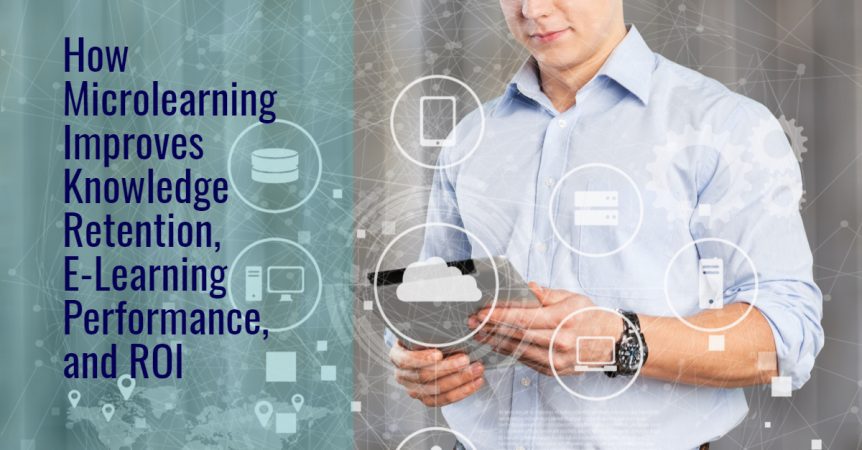How Microlearning Improves Knowledge Retention, E-Learning Performance, and ROI
Microlearning is a training strategy commonly used in e-learning. It involves presenting information to learners in small, bite-sized chunks. Each chunk typically takes minutes to complete and includes one central idea or new piece of information.
The main reason for using microlearning is to improve return on investment through better e-learning course performance. This is achieved because microlearning improves knowledge retention. Let’s look at how.
Spaced Repetition
We have known for some time that people generally forget what they learn soon after learning it if they don’t use the information. This was outlined in a graph back in the late 1800s by German psychologist Hermann Ebbinghaus. That graph shows that if we don’t use the information we have learned, we forget 50 percent of it within an hour and 90 percent within a month.
Spaced repetition helps to solve this. It facilitates learning by repeating information that has been learned in subsequent microlearning chunks. The time between each repetition is gradually increased until the information moves into the learner’s long-term memory.
Microlearning and spaced repetition are two e-learning strategies that work perfectly together, with each enhancing the other.
Prevents Mental Fatigue
We all have short-term and long-term memory. In simple terms, knowledge has to pass from a learner’s short-term memory into their long-term memory for it to be retained. That takes time, however, plus we have limited short-term memory capacity. As a result, overloading it with too much information results in less information being retained.
Microlearning gives learners time to pause and process information before moving on. This facilitates the process of transferring knowledge into long-term memories.
Better Engagement
Learners are more engaged with microlearning content than traditional learning materials. One of the reasons for this goes back to the point above – microlearning prevents mental fatigue. When learners only have to focus for a short period of time, they are much more likely to get fully engaged.
Plus, learners who are engaged with the content and want to learn are in a better position to retain the information.
Improved Structure
With microlearning, you should only present one piece of information at a time. This requires careful planning of the structure of your e-learning course to bring the learner through the topic step by step. More often than not, the result is a better overall structure and learning experience.
The Scaffolding Concept
People learn progressively, building on the knowledge they have previously learned, i.e., they learn something and then use that knowledge to help them learn the next thing. This is known as the scaffolding concept as it resembles the process of putting up scaffolding on a building, i.e., you build up the scaffolding section by section and piece by piece from the ground up.
Microlearning is the ideal tool for utilising the scaffolding concept in your e-learning courses.
Less Clutter
Focusing on only one piece of information or concept in each microlearning chunk, and keeping each chunk as short as possible, forces you to remove any superfluous information and clutter. This removes things that could otherwise distract the learner, allowing them to concentrate on the important information.
Immediate Feedback
Microlearning gives you the opportunity to provide regular and immediate feedback to learners as they progress through the course. This gives learners a real-time understanding of their strengths and weaknesses. They can then work on the areas that need improvement.
Learner Autonomy
Learners differ in a number of ways, including how fast they learn. Therefore, allowing learners to learn at their own pace facilitates knowledge retention, i.e., slower learners can spend more time on sections when they need to, while faster learners can progress at their own pace without feeling frustrated about being held back. Microlearning helps make this self-paced learning possible.
It also makes it easy to repeat a section that you have already completed. With a more traditional e-learning course that has longer sections, it takes more time for learners to go back over the content. With microlearning, the learner just has to go back to the start of the short chunk they have just completed.
Consistent Learner Experience
This point is a differentiator between microlearning and classroom-based learning. In classroom-based learning, knowledge retention can be impacted because of various factors external to the learning materials that you have produced. This results in inconsistent learner experiences.
These inconsistencies can occur for a range of reasons, including the quality of the facilities that people attend for classroom-based training. However, the main cause of training inconsistency is the quality of trainers.
Whatever the reason, the result is the same. For example, you could have one group of learners in Saudi Arabia who have a good learning experience so have high retention rates, while your team in the UAE has a poor learning experience. This poor experience will impact knowledge retention rates among your UAE team.
Microlearning solves this instantly as everyone can use the same e-learning course, ensuring consistency throughout your organisation.
Easier to Fit into Learners’ Schedules
In the modern world, it can be difficult to find the time required to complete a standard-size training module. With microlearning, the time commitment required by learners is significantly reduced. Even if they only have a few minutes, they can make progress through the training course.
Investing Wisely in Training
It is important to get maximum returns on the investments you make in training. A useful metric for measuring those returns is knowledge retention, as it impacts everything from behavioural change to improved business performance. Given that knowledge retention is so important, it makes sense to use microlearning.
